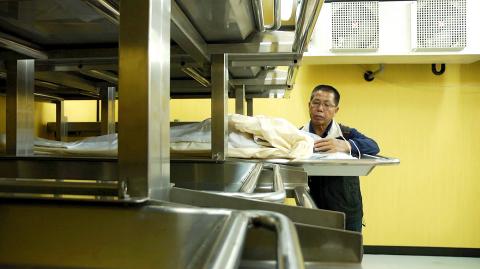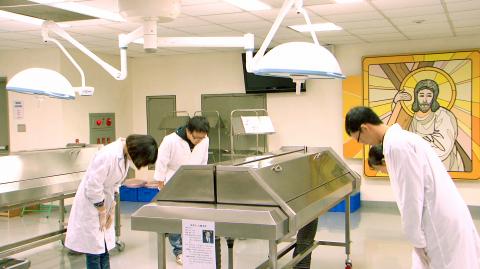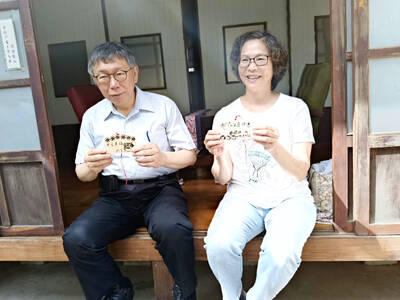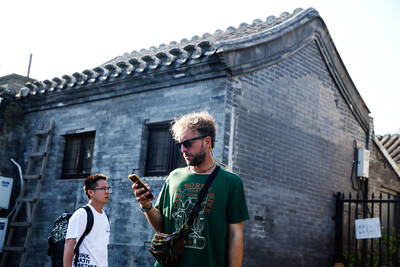Don’t be put off by the dead body in the opening scene of Silent Teacher — you’ll likely be moved to tears later. No exaggerating here, there was much sobbing heard during the screening. Director Maso Chen (陳志漢) tackles a potentially morbid subject with sensitivity, crafting a tender and informative documentary on “silent teachers” (大體老師), or people who have donated their body to medical schools for dissection.
Due to the traditional belief in keeping one’s corpse whole, medical schools in Taiwan often have difficulty finding cadavers for their students to dissect in anatomy classes. As a result, the cadaver-to-medical student ratio in Taiwan is five times lower than that of Western countries. Here, these bodies are literally treated as “teachers,” with the students bowing and thanking them after each session.
It could be argued that the film’s protagonist is Hsu Yu-e (徐玉娥), a Chiayi woman whose body is being prepared for dissection at Fu Jen Catholic University’s medical school (the process takes about a year), but the narrative is primarily told through Lin Hui-tsung (林惠宗), her husband of 23 years, who travels to Taipei every month to update his wife’s body on how the family is doing. Both of them had signed up to donate their bodies for education.

Photo courtesy of The Classic Vision
The film also places much attention on the medical students and staff, especially as they have to interact with their designated corpse’s family members, who are pretty much involved in every step of the process (except for watching the dissection, which they can’t bear to do).
The professor repeatedly stresses that the cadaver is more than just a body to dissect — it is a lesson in respecting life. And like the class, the scope of the film reaches way beyond the subject matter, which is clearly and cohesively presented — the director also explores deeper themes on life, death and humanity.
We hear their daughter discussing what she has learned about life from this experience, while the anatomy class professor ponders whether she can handle her students dissecting her own mother, who has volunteered to be a silent teacher when she dies. There’s also discussion of religion through how a Catholic university handles bodies from people with Buddhist or Taoist backgrounds. The cause of Hsu’s death is revealed indirectly as the students dissect her body.

Photo courtesy of The Classic Vision
Through masterful editing, much of the story is told through conversations and slice-of-life scenes — and there is much material to choose from as the director spent a year documenting Lin’s life, after Hsu’s body arrived at Fu Ren. For example, we only learn that he visits his wife’s body often through his casual banter with the medical staff. Lin is an ideal candidate for this type of story — he appears optimistic most of the time as we watch him try to carry on with his life — even posing for selfies in a karaoke bar. His positive attitude makes the film less heavy, but his grief is still there, and our hearts break when he breaks down.
Since there are essentially two timelines going on with the family and the medical school — which only converge every now and then — it makes for some interesting juxtaposition scenes that the director fully makes use of. And while the cadaver is frequently shown in the film, it is treated delicately but not too conservatively. We see just enough to realize that this is without a doubt reality, but not too much that we would feel uncomfortable.
Running just 73 minutes, there’s a lot packed into this film, but it doesn’t seem rushed — in fact it’s probably just long enough. When a viewer leaves the theater full of emotions, thoughts and new information without any hints of boredom — that’s all the signs of a good documentary.

Climate change, political headwinds and diverging market dynamics around the world have pushed coffee prices to fresh records, jacking up the cost of your everyday brew or a barista’s signature macchiato. While the current hot streak may calm down in the coming months, experts and industry insiders expect volatility will remain the watchword, giving little visibility for producers — two-thirds of whom farm parcels of less than one hectare. METEORIC RISE The price of arabica beans listed in New York surged by 90 percent last year, smashing on Dec. 10 a record dating from 1977 — US$3.48 per pound. Robusta prices have

The resignation of Taiwan People’s Party (TPP) co-founder Ko Wen-je (柯文哲) as party chair on Jan. 1 has led to an interesting battle between two leading party figures, Huang Kuo-chang (黃國昌) and Tsai Pi-ru (蔡壁如). For years the party has been a one-man show, but with Ko being held incommunicado while on trial for corruption, the new chair’s leadership could be make or break for the young party. Not only are the two very different in style, their backgrounds are very different. Tsai is a co-founder of the TPP and has been with Ko from the very beginning. Huang has

A few years ago, getting a visa to visit China was a “ball ache,” says Kate Murray. The Australian was going for a four-day trade show, but the visa required a formal invitation from the organizers and what felt like “a thousand forms.” “They wanted so many details about your life and personal life,” she tells the Guardian. “The paperwork was bonkers.” But were she to go back again now, Murray could just jump on the plane. Australians are among citizens of almost 40 countries for which China now waives visas for business, tourism or family visits for up to four weeks. It’s

A dozen excited 10-year-olds are bouncing in their chairs. The small classroom’s walls are lined with racks of wetsuits and water equipment, and decorated with posters of turtles. But the students’ eyes are trained on their teacher, Tseng Ching-ming, describing the currents and sea conditions at nearby Banana Bay, where they’ll soon be going. “Today you have one mission: to take off your equipment and float in the water,” he says. Some of the kids grin, nervously. They don’t know it, but the students from Kenting-Eluan elementary school on Taiwan’s southernmost point, are rare among their peers and predecessors. Despite most of